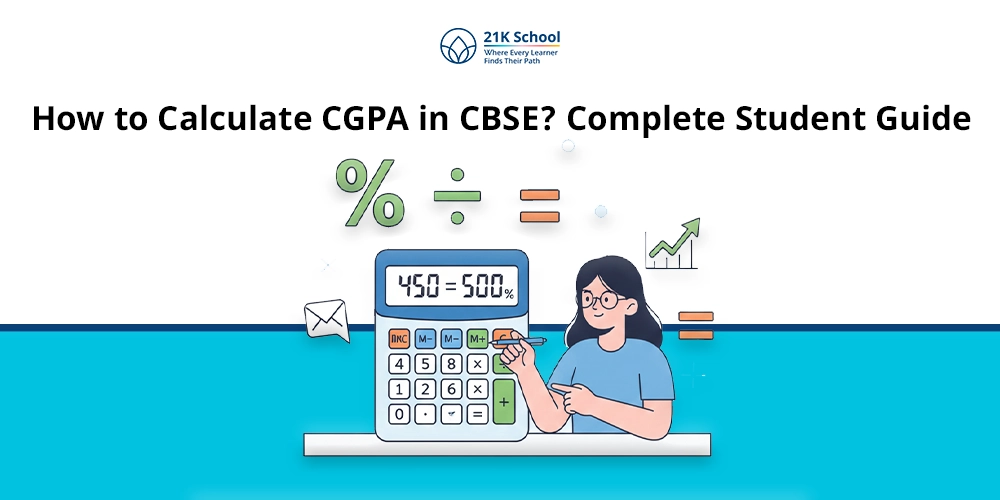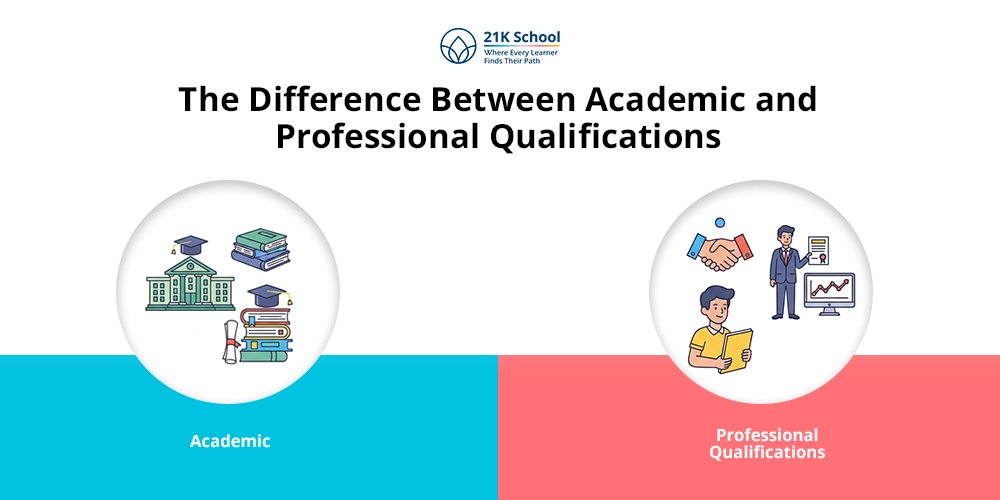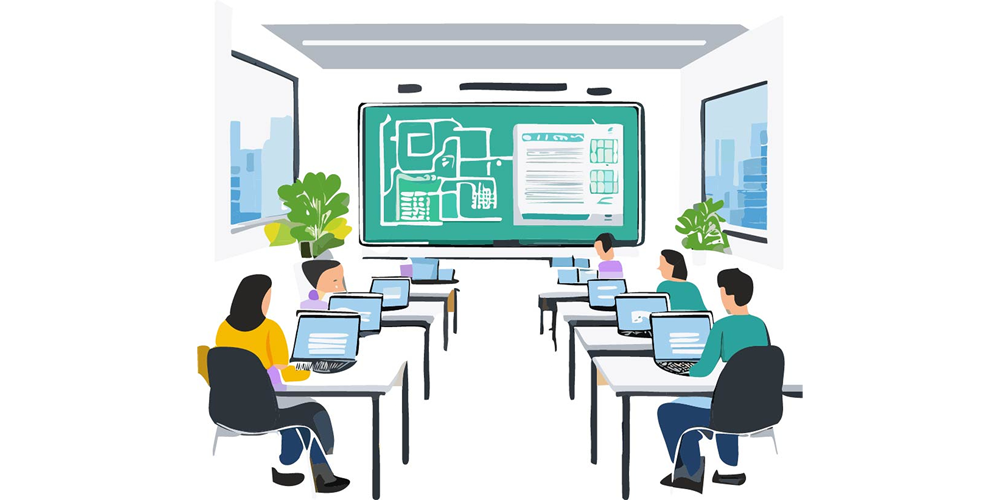
Contents
- What is a Smart Classroom?
- Why Smart Classrooms?
- Key Features and Components of a Smart Classroom
- Different Types of Smart Classrooms
- Advantages of Smart Classrooms
- Smart Classrooms Vs Traditional Classrooms
- How Smart Classrooms are Improving Student Outcomes?
- How Smart Classrooms Support Teachers?
- Challenges of Implementing Smart Classrooms
- Role of 21K School in Integrating Smart Classroom Technology
- Real-World Cases & Data
- Conclusion
What is a Smart Classroom?

A smart classroom is a technology-enhanced teaching space designed to improve learning outcomes
These classrooms include tools like the smartboard, the projector, the computer, and the internet connection to make the classroom effective and engaging.
At 21K School, is an online homeschooling platform, we focus on the role of smart classes in homeschooling and offer the students various resources and materials with the content of classes.
Why Smart Classrooms?
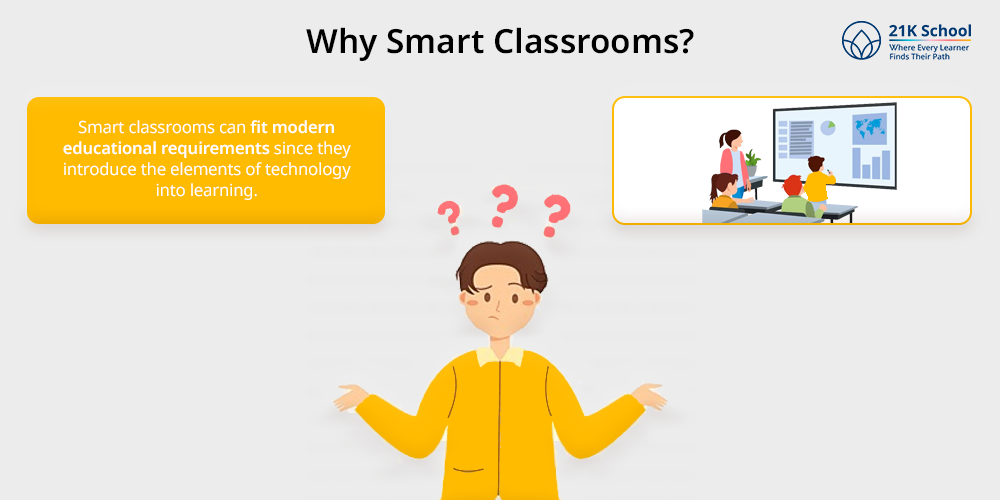
Smart classrooms can fit modern educational requirements since they introduce the elements of technology into learning.
These tools often increase student enthusiasm and engagement, leading to improved performance.
At 21K School, we believe that smart classrooms are suitable for students to ensure their readiness for future professions and to get correspondent 21st-century competencies/skills.
Key Features and Components of a Smart Classroom
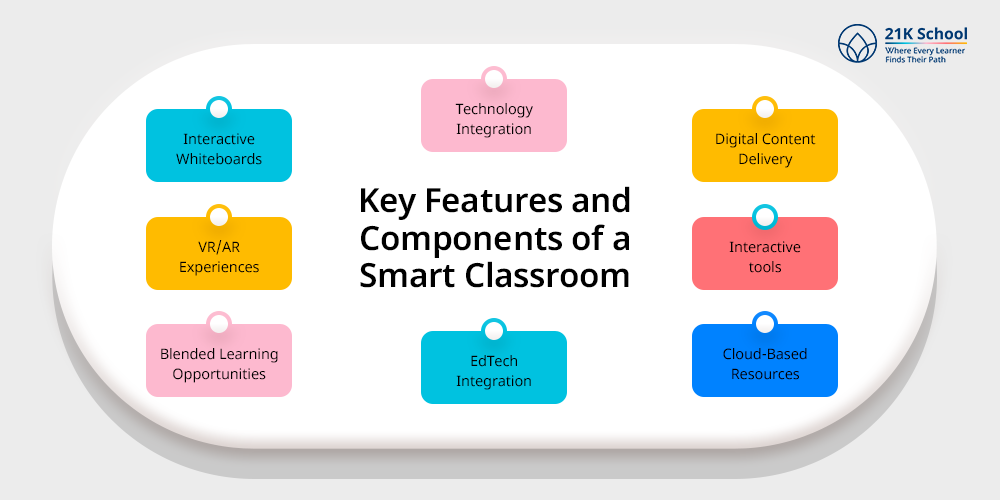
A smart classroom includes tools with interactive displays, digital technology, and collaborative learning engagements. Together, these elements form an interactive and engaging learning space for students.
Here are the key features and components of a smart classroom:
1. Interactive Whiteboards
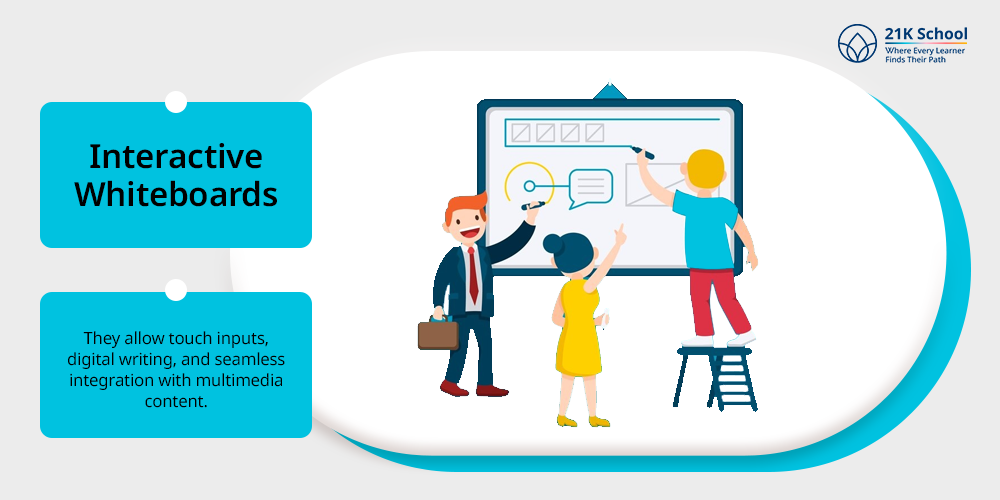
Interactive whiteboards replace traditional blackboards and enable teachers to present lessons visually and engagingly.
They allow touch inputs, digital writing, and seamless integration with multimedia content. Students can also participate in activities on the board, making learning more hands-on and collaborative.
2. Technology Integration
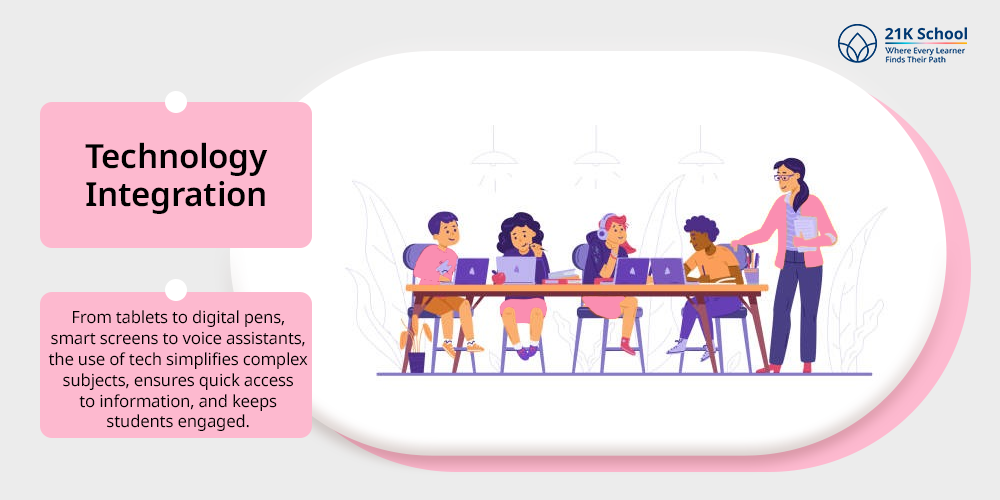
The heart of a smart classroom lies in how well it integrates technology in education.
From tablets to digital pens, smart screens to voice assistants, the use of tech simplifies complex subjects, ensures quick access to information, and keeps students engaged throughout the session.
3. Digital Content Delivery
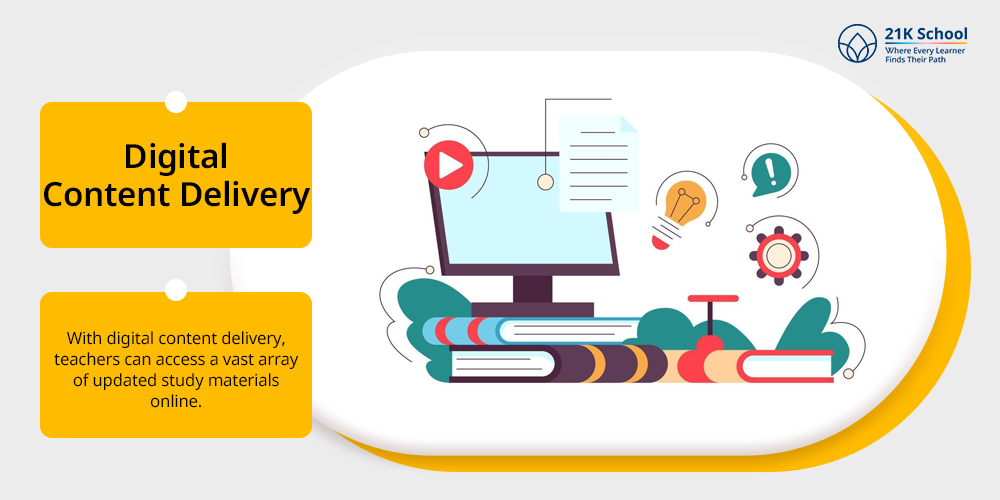
Gone are the days of heavy textbooks and limited resources. With digital content delivery, teachers can access a vast array of updated study materials online.
Whether it’s a diagram, video tutorial, 3D model, or infographic, smart classrooms allow content to be tailored to suit different learning styles.
4. Interactive Tools
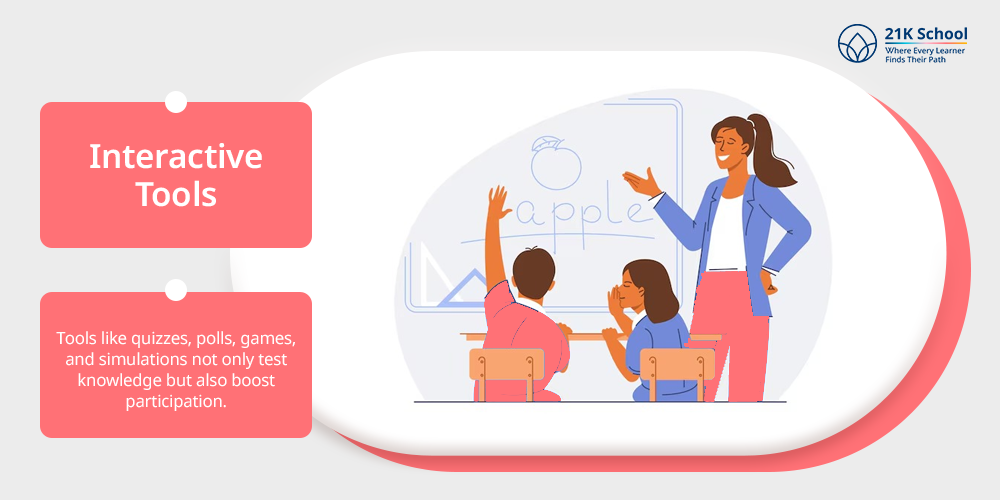
Smart classrooms thrive on interactivity. Tools like quizzes, polls, games, and simulations not only test knowledge but also boost participation.
These elements ensure that every student is part of the learning journey, even the shy ones who may not speak up in traditional setups.
5. Cloud-Based Resources
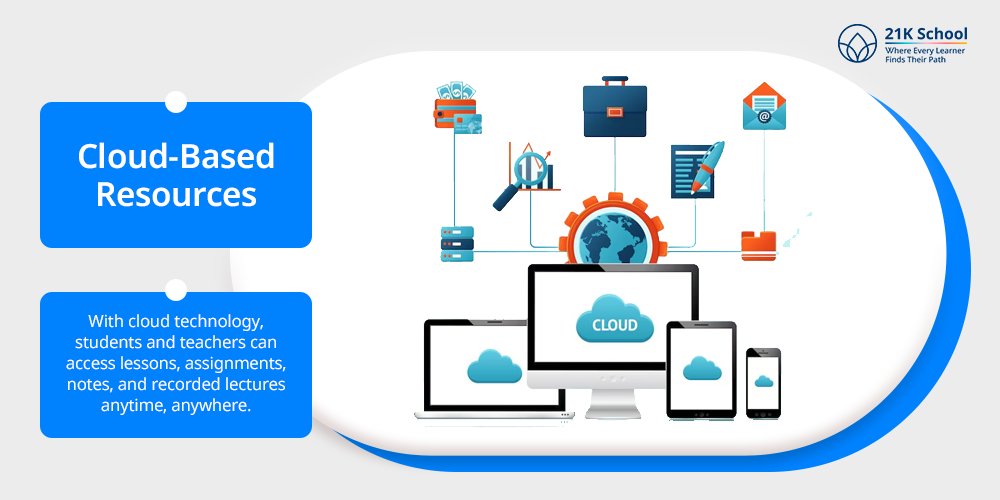
With cloud technology, students and teachers can access lessons, assignments, notes, and recorded lectures anytime, anywhere.
This supports a flexible and continuous learning experience, even outside the classroom. It also ensures better collaboration and easier sharing of resources.
6. EdTech Integration
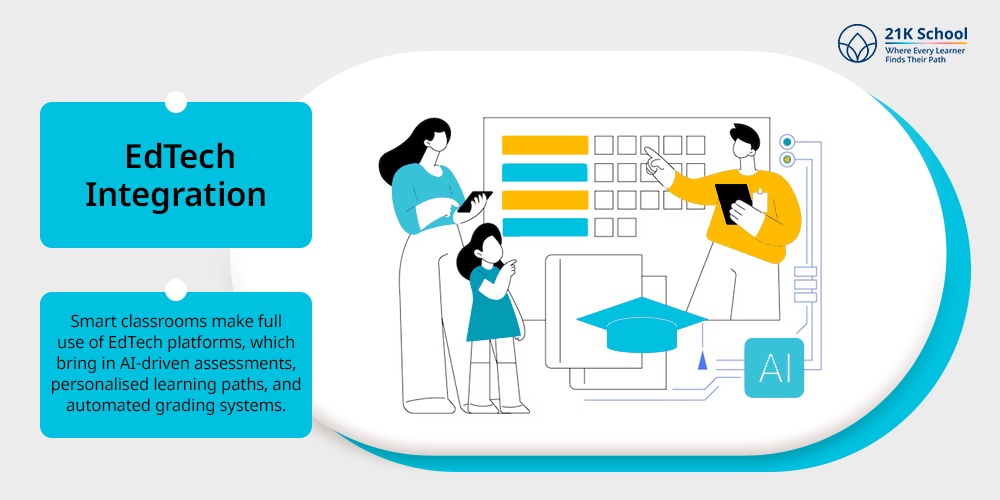
Smart classrooms make full use of EdTech platforms, which bring in AI-driven assessments, personalised learning paths, and automated grading systems.
This integration helps educators identify learning gaps quickly and modify their approach for better outcomes.
6. Blended Learning Opportunities
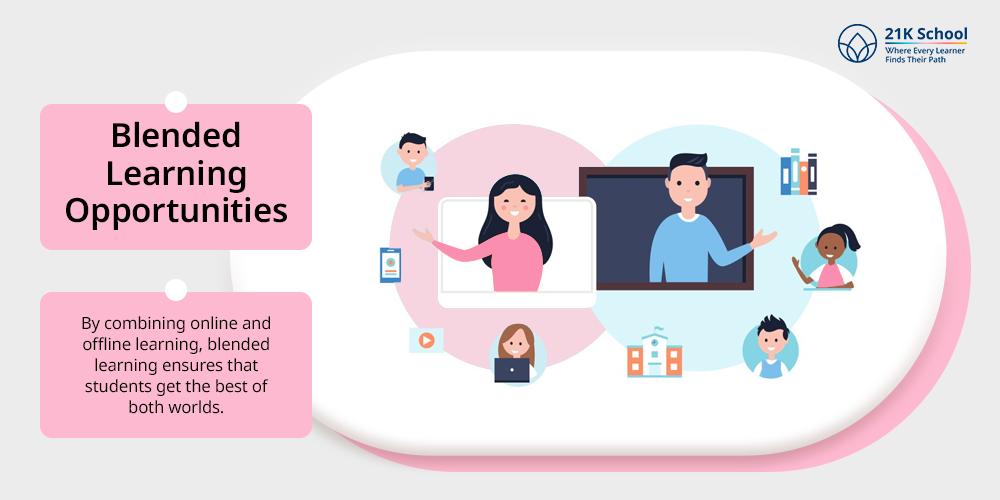
By combining online and offline learning, blended learning ensures that students get the best of both worlds.
Smart classrooms support this model by allowing students to learn at their own pace, revisit difficult topics through recorded sessions, and apply knowledge through interactive classroom discussions.
Read about the benefits of blended learning.
7. VR/AR Experiences
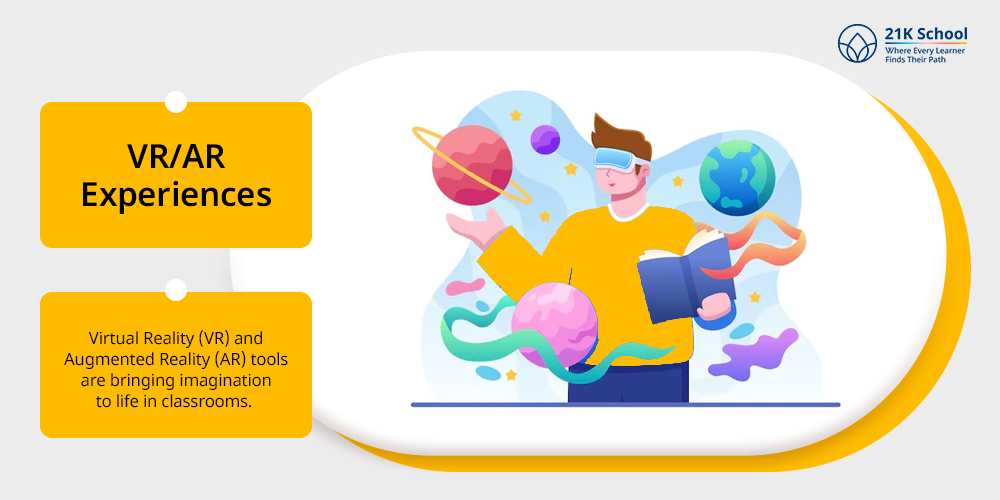
Virtual Reality (VR) and Augmented Reality (AR) tools are bringing imagination to life in classrooms. From exploring the solar system to dissecting a virtual frog, these experiences make learning immersive and memorable, helping students grasp complex topics through simulation and visual storytelling.
1. Projectors
Though basic, modern projectors remain an essential smart classroom component.
Paired with smart boards or screens, they help display presentations, videos, and other learning materials clearly to the entire class, ensuring everyone stays on the same page.
2. Learning Management Systems (LMS)
An LMS is a digital platform that manages assignments, grades, feedback, and communication between teachers and students.
It centralises all classroom activities and gives students a clear roadmap of their academic progress. Teachers benefit from easy scheduling, attendance tracking, and performance analysis.
3. Internet Connectivity
Reliable internet access is the backbone of any smart classroom. It ensures uninterrupted access to cloud resources, real-time collaboration, online assessments, and virtual learning tools.
Strong connectivity bridges the gap between global knowledge and local classrooms.
4. Audio-Visual Aids
High-quality audio-visual equipment, including speakers, microphones, smart TVs, and cameras, helps in delivering lessons.
These tools ensure that every student, regardless of seating, can hear, see, and engage with the lesson content effortlessly.
Different Types of Smart Classrooms
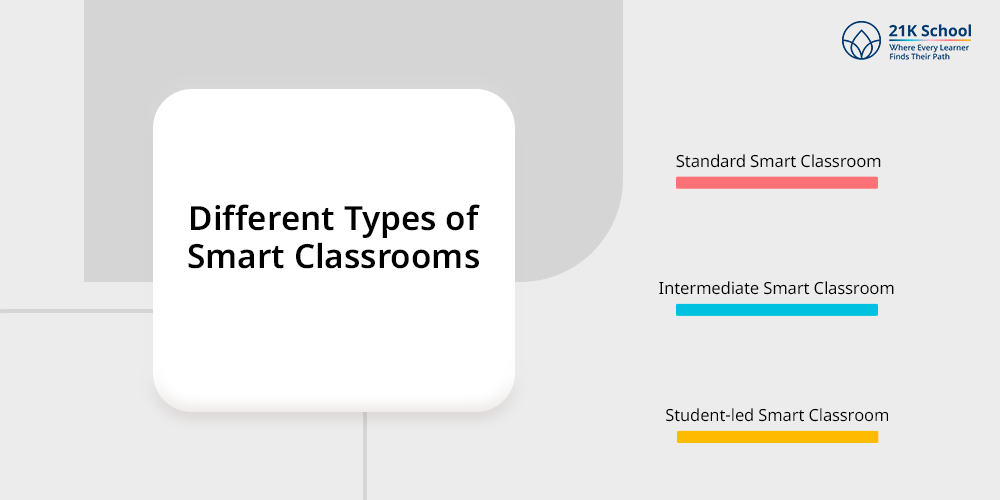
1. Standard Smart Classroom
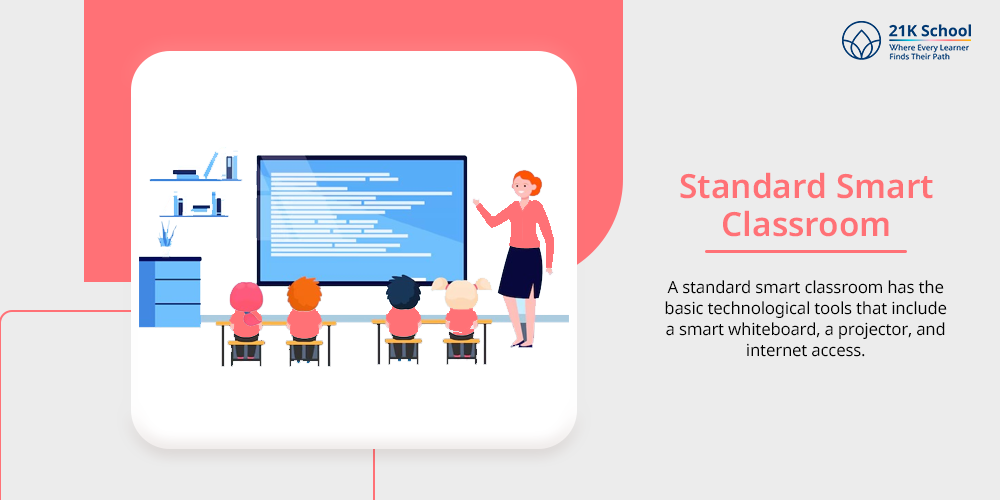
A standard smart classroom has the basic technological tools that include a smart whiteboard, a projector, and internet access.
The lectures can convey digital materials, videos, and lessons through digital devices, hence making learning lively for the students.
Such a setup is well-suited for schools or homeschooling setups that are beginning to integrate technology into their teaching methods.
2. Intermediate Smart Classroom
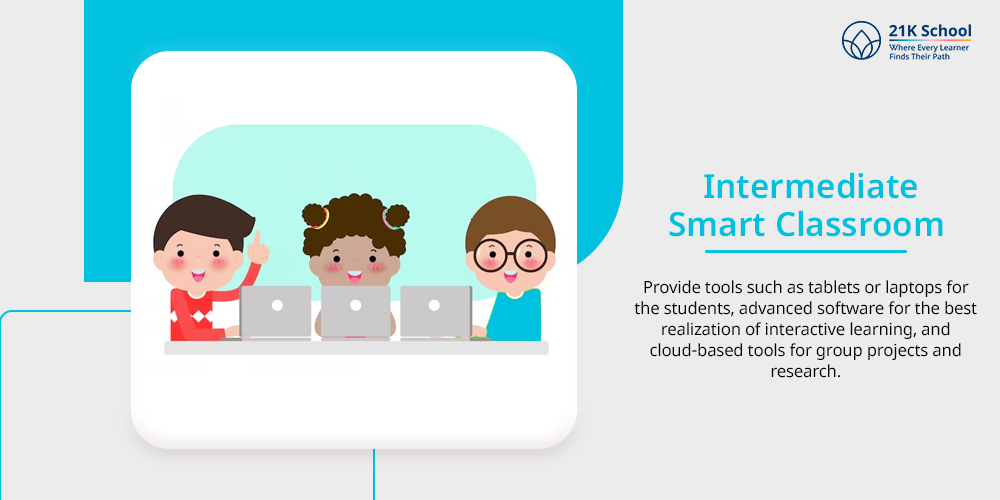
An intermediate smart classroom would contain all the elements of a standard smart classroom but would also provide such tools as tablets or laptops for the students, advanced software for the best realisation of interactive learning, and cloud-based tools for group projects and research.
This kind of classroom increases the level of students’ participation and allows for personalised learning experiences, catering to individual student needs and learning paces.
3. Student-led Smart Classroom

A student-led smart classroom shifts the responsibility of learning to the student.
These classrooms use multiple technologies and media, which enable students to have full control of their learning process.
Another type of portable digital tools such as tablets and laptops or any portable device that is used in sharing educational applications for learning, information searching, and other tasks.
Such a type of classroom advances critical thinking, creativity, and problem-solving elements in the class.
Advantages of Smart Classrooms
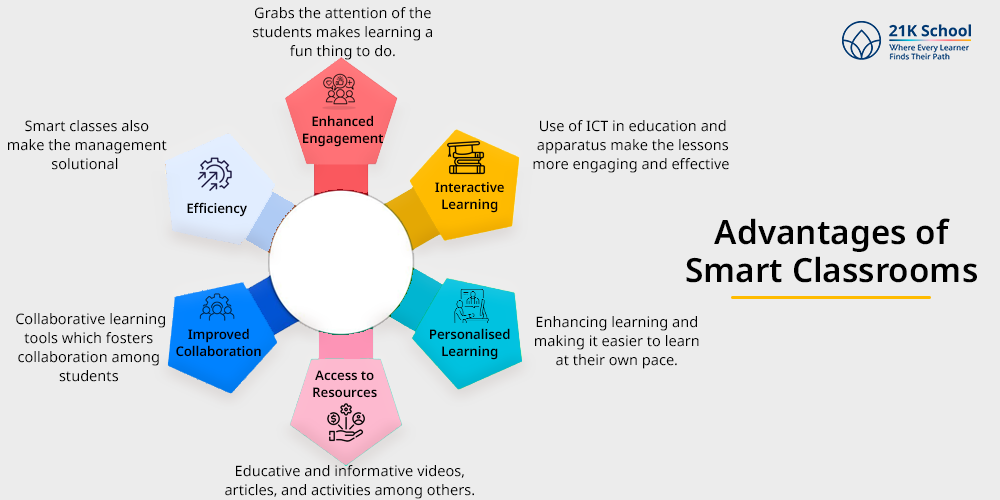
1. Enhanced Engagement: In smart classrooms, information is presented through multimedia, which is more effective because it grabs the attention of the students and, in the long run, makes learning a fun thing to do.
2. Interactive Learning: Other teaching aids include the use of interactive whiteboards, and the use of ICT in education
and apparatus make the lessons more engaging and effective since the teacher and the students can respond to one another in real-time.
3. Personalised Learning: Technologies facilitate a personalised approach towards students. The use of technology in teaching makes a difference in the way students learn, enhancing their learning and making it easier for them to learn at their own pace.
4. Access to Resources: With access to the internet and technology gadgets, students are in a position to access so many educational and informative videos, articles, and activities, among others.
5. Improved Collaboration: There are collaborative learning tools which foster collaboration among students, making them able to share work and ideas with other students regardless of the homeschooling setup that may be in place.
6. Efficiency: Smart classes help teachers save time with digital planning, scheduling, and resource sharing.
Smart Classrooms Vs Traditional Classrooms
Smart classrooms and traditional classrooms are both different aspects; the smart classroom includes the use of technology and modern terminologies to teach children with interactive classes, whereas the traditional classroom is an old method of teaching learning with the main focus on theoretical aspects.
However, traditional education has remained a primary mode of education, and in the 21st century, traditional education is also implementing digital classrooms to enhance the learning initiatives and to promote digital literacy among students.
Below, you can check the difference between the smart classroom and the traditional classroom.
| Aspects | Smart Classroom | Traditional Classroom |
| Definition | Smart classroom is an interactive and modern aspect of a learning environment that allows students to learn with the help of technology and technical terminologies. | The traditional classroom is an old method of teaching and learning, with the main focus on theoretical aspects. In the traditional method of learning, teachers are the sole conveyors of knowledge. |
| Resources | Smart classroom uses digital methods of learning via multimedia systems, such as projectors, digital boards, speakers, simulation, etc. | Traditional classrooms use old methods of learning, such as blackboards, books, notebooks, texts, etc. There is very limited updation of resources in |
| Assesments | In smart classrooms, there is a wide range of assessment procedures such as quizzes, puzzles, Q&A, etc. This interactive method allows kids to participate in the earning process and motivates them. | The traditional classrooms use old methods of assessment such as exams, class tests, MCQs, etc. Due to this method, children find it tough to maintain their interests. |
| Acceptance | Smart classrooms are a new initiative, and very few schools and educational institutes have adapted, due to resistance to change. | Traditional classroom teaching methods have remained a primary mode of education for a longer period of time, due to credibility and accountability. |
| Pedagogy | A smart classroom is student-centered and uses active learning strategies, which help in enhancing children’s engagement and motivation. | The traditional classroom is teacher-centred approach and provides passive learning, due to which students find it difficult to interact with teachers. |
| Examples | A smart classroom uses digitalboards, laptops, and tablets, with a teacher leading the classroom in an interactive way. | Traditional classroom uses a blackboard, tests, and a written format to teach students. Traditional education focuses on a theoretical approach more. |
How Smart Classrooms are Improving Student Outcomes?
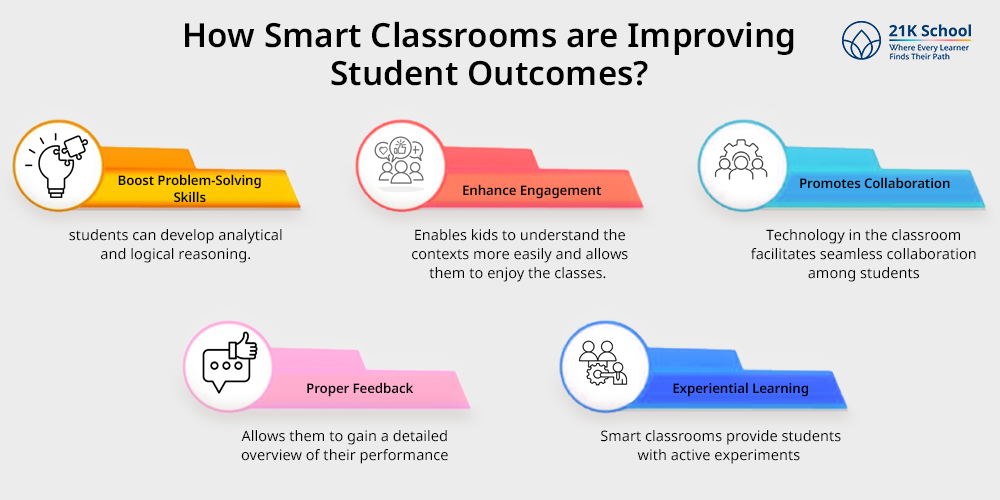
Smart classrooms not only provide quality and engaging classes but also help students to understand the concepts more easily through an interactive approach.
Smart education is implemented in both traditional schools and online education, with the help of technology and modern ethics.
Smart classrooms are known for improving students’ educational outcomes with the help of digital initiatives. Here is how smart classrooms are improving students’ outcomes.
- Boost Problem-Solving Skills: One of the effective aspects of the smart classroom is that it enhances problem-solving abilities among students. Through problem-solving skills, students can develop analytical and logical reasoning that helps them in their growth and career development.
- Enhance Engagement: Smart classrooms are an effective way to engage students in classroom education. Using technology and interactive learning experiences such as multimedia systems, digital boards, AR, and VR enables kids to understand the contexts more easily and allows them to enjoy the classes.
By using technology, students can also express their feelings and thoughts, which helps in advancing their thinking skills. - Promotes Collaboration: Smart classrooms are an effective way the help children interact with peers and their teachers. Technology in the classroom facilitates seamless collaboration among students, helps in removing all the barriers, and creates an engaging learning environment.
This enhances the effectiveness of shared knowledge and collective learning through cooperative methods. - Proper Feedback: Through the use of formative assessment tools, teachers can evaluate teachers are avail to evaluate students’ performance. In the smart classroom, students become more engaged as they get the opportunity to understand and share their weaknesses and improvements.
This allows them to gain a detailed overview of their performance and also allows teachers to create a proper study method. - Experiential Learning: Smart classrooms provide students with active experiments and practical exposure, with the help of technology.
Through technological integration, students are supposed to be imaginative, learn how to solve problems and come up with fresh ideas. This also enables teachers to understand the learning nature of students.
How Smart Classrooms Support Teachers?
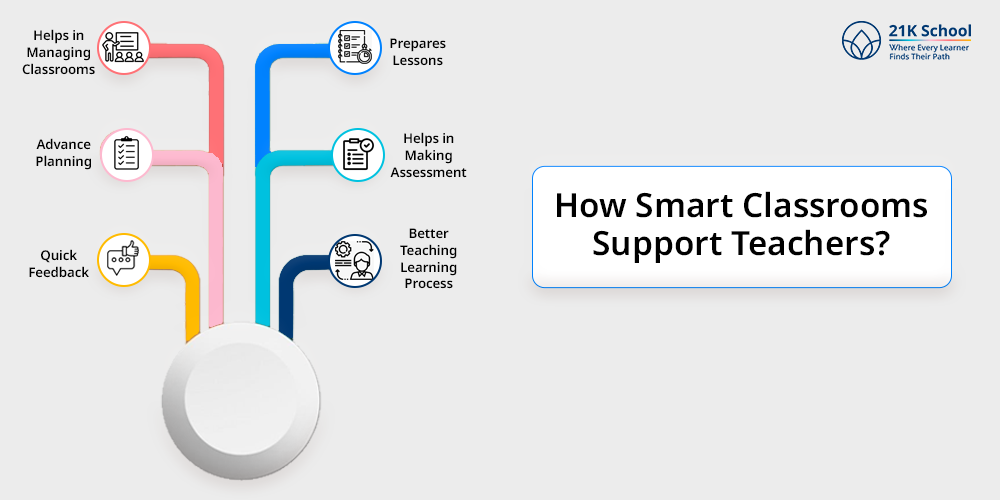
Smart classrooms are not limited to students but are also helpful for teachers as well. A smart classroom allows teachers to quickly access digital learning resources.
Teachers can use smart classroom hardware to access online content as well.
Smart classrooms are an incredible way to focus on students and provide them with personalised learning . Below, you can check how smart classrooms provide support to teachers.
- Helps in Managing Classrooms: Smart classrooms help teachers manage classrooms with the help of technology. This initiative helps teachers to manage the activities and enhance the experience of students as well. Smart classroom provides an innovative way to track attendance, digital charts, assignments, etc.
- Prepares Lessons: Through smart classrooms, teachers can effectively prepare their lessons in advance. This helps in saving their time and allows them to get a quick response, and makes students more engaged.
Advance planning helps teachers streamline lesson delivery and improve classroom engagement. This allows teachers to stay focused on their teaching rather than the self learning or preparation for the next plan..
- Helps in Making Assessment: Smart classrooms simplify assignment creation and assessment, allowing teachers to focus more on teaching. One of the incredible benefits of the smart classroom is that it provides teachers with ease in preparing assignments. Assignments are very necessary to judge the student’s performance, and they take so much time.
With the help of technology, this has become easy to make assessments and allows teachers to quickly conduct them. Through this, teachers can focus on the teaching process only and promote active education. - Quick Feedback: Smart classrooms help teachers to get feedback about the students’ performance and their learning outcomes. Through smart classrooms, teachers can understand the areas of improvement and weaknesses of students, and it also allows them to understand their learning objectives.
- Better Teaching Learning Process: Smart classrooms are an amazing way to enhance the teaching and learning process among students and teachers. Smart classrooms help in building teacher-student relationships and allow them to develop interest and motivation towards education.
Challenges of Implementing Smart Classrooms
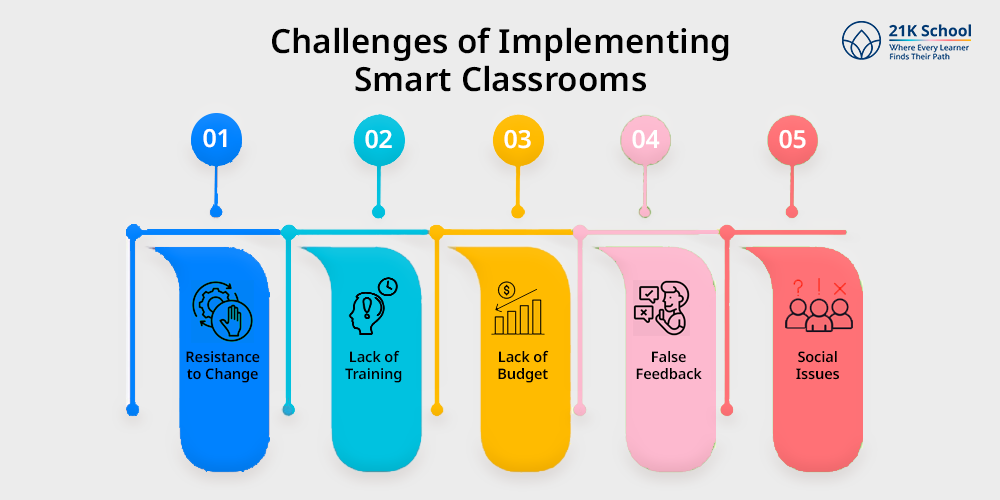
There is no doubt that smart classrooms are an amazing way to enhance the teaching and learning process.
Smart classrooms allow students to engage in productive activities and help in developing critical thinking skills, this also allows them to build connections confidently.
But even with numerous benefits, it becomes challenging to implement smart classrooms. Here are the challenges faced while implementing smart classrooms.
- Resistance to Change: Resistance to change is one of the major reasons that hinders the implementation of a smart classroom.
Most teachers and students are accustomed to the traditional method of teaching and learning, and adapting new technical skills becomes tough for them. For this reason, many don’t want to change. - Lack of Training: Smart classrooms are all about technology and technical terminologies; many teachers are not equipped to engage with technical resources.
So it is essential to provide them with proper training and assistance to effectively utilize the technology and implement smart education in smart classrooms. - Lack of Budget: Implementing smart classrooms requires a lot of budget as it needs computers, projectors, displays, internet, and so on.
Due to a lack of funds, it becomes tough to implement smart classrooms in every school. However, the sizable market for education presents chances for mass production, which might contribute to cost reductions. - False Feedback: False feedback is one of the major reasons that hinders the process of smart classrooms. False feedback from students in tech studies misleads the teachers to understand the concepts and leads to incorrect data input.
- Social Issues: Smart education system implementation may be hampered by a lack of familiarity with contemporary technology. This creates challenges for educational institutes to implement smart classroom strategies. A proper knowledge and digital literacy are essential for promoting smart education in schools.
Role of 21K School in Integrating Smart Classroom Technology
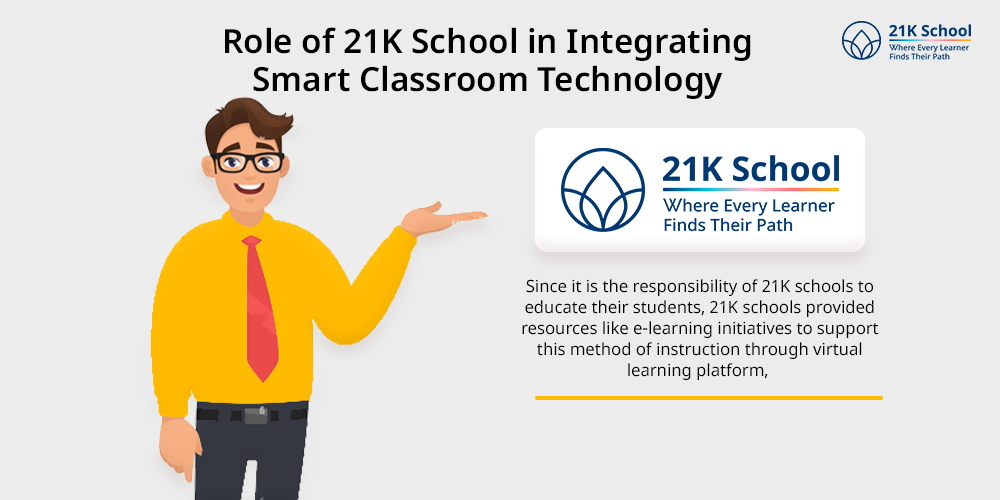
21K school plays an integral role in promoting smart classroom initiatives.
As a leader in virtual education, 21K School provides resources like e-learning initiatives to support this method of instruction through virtual learning platform, so that students well-prepared for the demands of the 21st-century workforce.
Because education is always evolving, smart classrooms will undoubtedly be one of the most important aspects of education in the future.
21K school provides an online learning experience to students through interactive and engaging methods.
Real-World Cases & Data
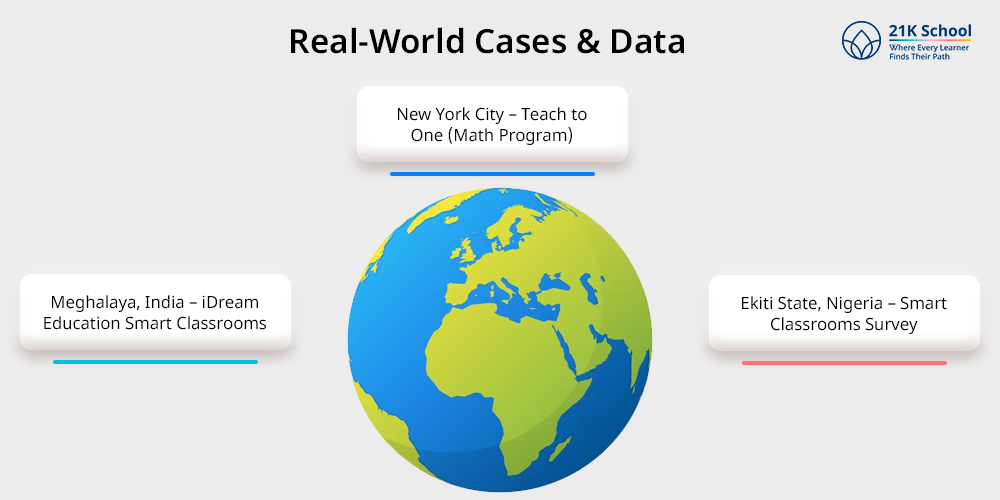
Here are some real-life examples and proof of the success of smart classrooms:
1. Meghalaya, India – iDream Education Smart Classrooms
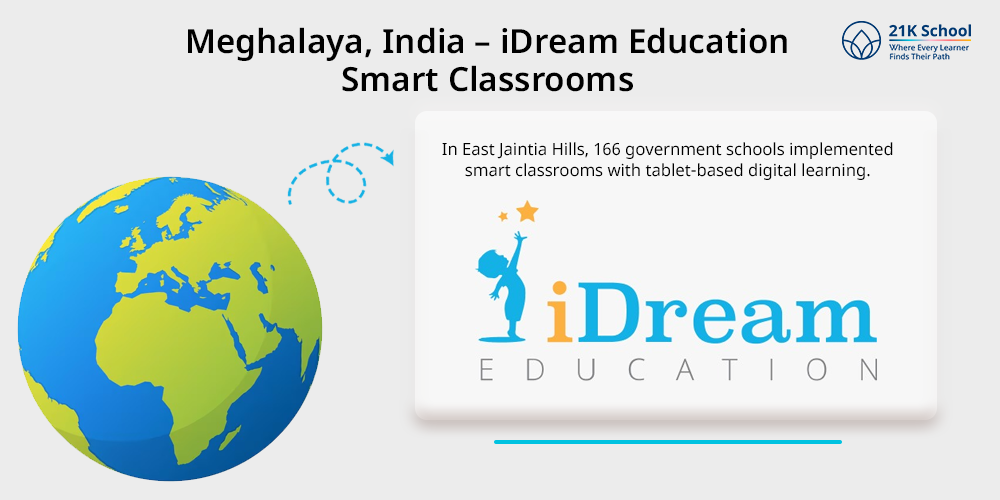
In East Jaintia Hills, 166 government schools implemented smart classrooms with tablet-based digital learning.
Result: Pass rates jumped from 25–28% to around 60% after introducing smart education and tailored bridge courses.
2. New York City – Teach to One (Math Program)
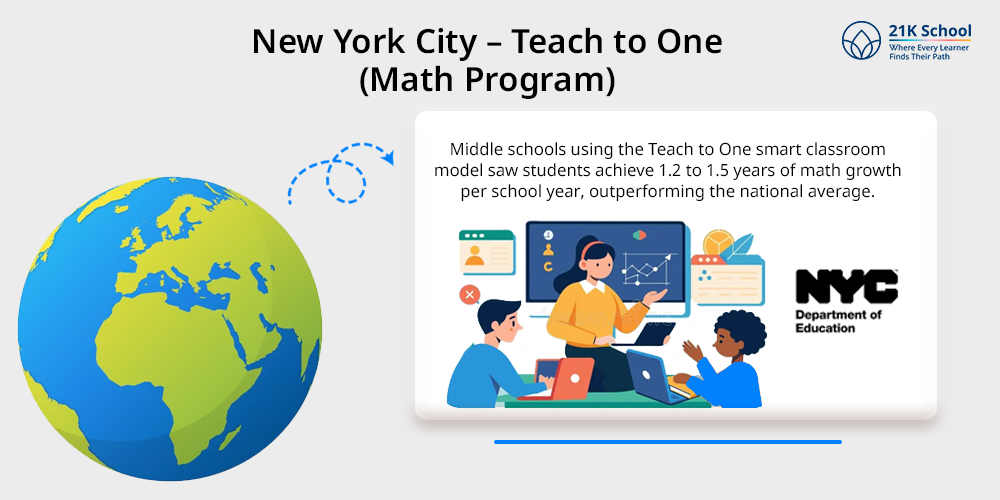
Middle schools using the Teach to One smart classroom model saw students achieve 1.2 to 1.5 years of math growth per school year, outperforming the national average.
Read more on Wikipedia – Teach to One
3. Ekiti State, Nigeria – Smart Classrooms Survey
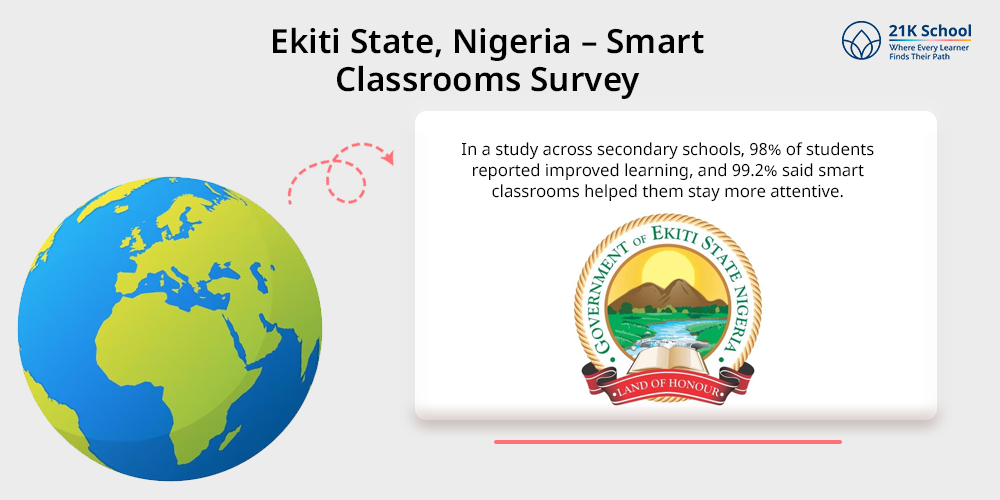
In a study across secondary schools, 98% of students reported improved learning, and 99.2% said smart classrooms helped them stay more attentive.
Read the full research on ResearchGate
Conclusion
Smart classrooms simplify assignment creation and assessment, allowing teachers to focus more on teaching.
The use of smart classrooms is the future of learning styles; the implementation of smart facilities yields benefits; that will be beneficial for students.
Incorporation of technology in the classroom should be done in the right manner as it can make learning fun and more engaging as well as make it personal.
At 21K School it was our duty to impart education to the students, and in aid of this style of learning, we offered facilities such as smart classes for our smart children so that when they are out there to face this world in this 21st century they could stand tall.
That is why as education is constantly changing smart classrooms are sure to be one of the most crucial factors in education in the future.

